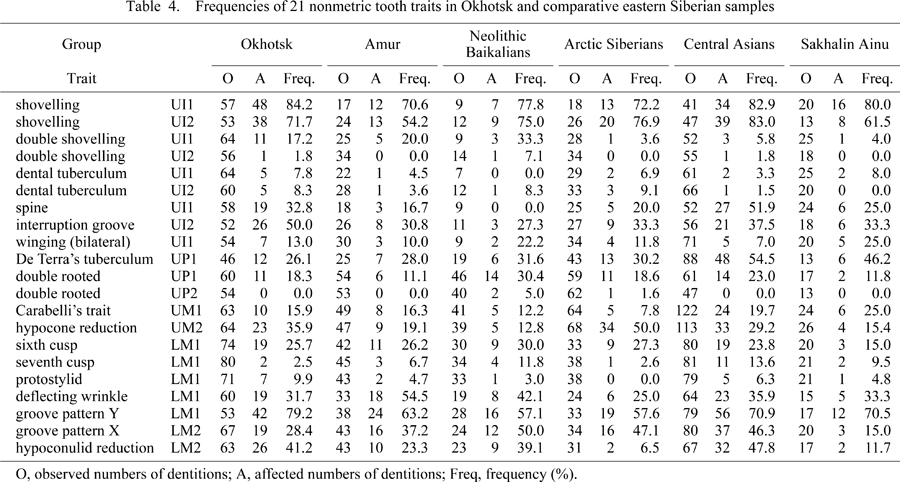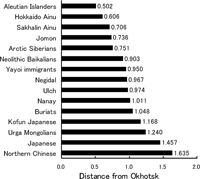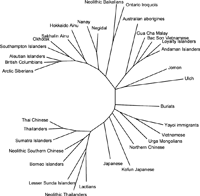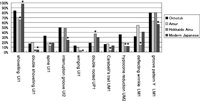| Correspondence to: Hirofumi Matsumura, Department of Anatomy, Sapporo Medical University, South 1, West 17, Sapporo 060-8556, Japan. E-mail: hiromura@sapmed.ac.jp Published online 10 April 2009 in J-STAGE (www.jstage.jst.go.jp) DOI: 10.1537/ase.080513 |
Archeological surveys have revealed that the earliest settlement of Hokkaido, the northernmost main island of the Japanese archipelago, dates back to the Upper Paleolithic, at least 20000 years BP (Utagawa, 1995). Nevertheless, the prehistoric human skeletal remains recovered from the sites in Hokkaido are younger than the Middle Holocene period (Yamaguchi, 1981). Based on the skeletal remains, anthropological perspectives have suggested that, in the population history of Hokkaido, the Jomon people who occupied this island in the Neolithic period (c. 12000–2300 years BP) later descended to the present-day Ainu through the Epi-Jomon (3rd century BC–7th century AD) and medieval Satsumon (8–14th centuries) cultural periods (Yamaguchi, 1981, 1982, 1992; Hanihara K., 1985, 1991, 1998; Ishida and Kondo, 1999; Dodo and Kawakubo, 2002; Ossenberg et al., 2006). Apart from this population lineage, the Okhotsk culture flourished in portions of Hokkaido and the outlying archipelago including Sakhalin and the Kuril islands, between the 5th and 11th centuries AD (Kikuchi, 1978; Maeda, 2002; Amano, 2003; Hudson, 2004). This culture is obviously different from the Epi-jomon and Satsumon cultures, which were contemporary with the Okhotsk culture. The Okhotsk people were already well adapted to the subarctic zone and brought technological and behavioral skills to the region that allowed them to very successfully pursue the hunting of large marine animals such as whales and sea-lions, and also exploit the diverse range of other resources in the region (Hudson, 2004). Archeologically, the origins of the Okhotsk culture appear to lie in the lower Amur River region of the Russian Far East from where the culture spread to Sakhalin and then Hokkaido and the Kuril Islands (Kikuchi, 1978; Amano, 2003; Hudson, 2004).
These relative latecomers were morphologically different from the Jomon and Hokkaido Ainu with respect to their extremely robust jaws and very flat nasal region, features that are common to Northeast Asian morphology in general. Initially the Okhotsk people were considered to be akin to Aleutian Islanders (Kodama, 1947, 1948). However, more extensive studies of Okhotsk skulls emphasized the kin closeness to the ethnic groups in eastern Siberia such as the Ulch and Nanay people currently distributed along the lower Amur River Basin (Yamaguchi, 1974; Ishida, 1988, 1996; Kozintsev, 1990, 1992). The most recent mitochondrial (mt) DNA analysis (Sato et al., 2007) also demonstrated the close similarity of the genetic haplotype between the Okhotsk and Amur peoples. Further extensive cranial study by Komesu et al. (2008) found a close affinity based on nonmetric features not only to the Amur but also to the Neolithic Baikalians.
Hence, although thus the skeletal morphology of the Okhotsk people has been studied by many researchers over the last half century, the features of their dental morphology are still little known. A preliminary study by Hanihara, T. (1991) using dental remains from Omisaki site in the far north of Hokkaido Island, despite the quite small sample size, found some metric features common to Northeast Asians in this Okhotsk group. Recently, a large numbers of Okhotsk human remains held at the Hokkaido University Museum became available for anthropological study, allowing us to undertake a more extensive analysis of the dental morphology of Okhotsk people. The aim of this paper was to examine metric and nonmetric dental traits of the Okhotsk people and to consider their biological affinity with East Asians, encompassing surrounding east Siberians and peoples in the subarctic America and Pacific regions.
The Okhotsk sample is represented by five sites in northern/eastern Hokkaido and single site on Sakhalin Island (Table 1, Figure 1). From northern Hokkaido, 40 skeletal individuals came from the Hamanaka and Hamanaka 2 sites on the island of Rebun (Ito and Kodama, 1963; Ishida et al., 1994a, 2002; Maeda and Yamaura, 1994; Ishida and Matsumura, 2000) and from the Omisaki site in the city of Wakkanai (Mitsuhashi and Yamaguchi, 1961, 1962a, b, c; Ishida, 1988; Yamaguchi, 1995). From adjacent Sakhalin Island, the Susuya site produced eight skeletal specimens belonging to the early Okhotsk cultural phase (Kiyono, 1925). The remaining 88 individuals from eastern Hokkaido, came from the Moyoro site in the city of Abashiri (Kodama, 1947, 1948; Ito, 1965, 1971) and from the Utoro-Jinjayama site in the town of Shari (Ishida et al., 1993, 1994b). The Moyoro materials contained specimens from medieval and early modern times, beyond the period of Okhotsk culture, and the people probably interbred with the Ainu or were Ainu themselves considering the cranial morphology (Ito, 1965). Such chronologically outranging specimens were confirmed by radiocarbon dating undertaken by one of us (M.Y., unpublished), and were excluded from the current dental study. All of these Okhotsk specimens are stored at Sapporo Medical University, the Hokkaido University Museum, and Kyoto University.
 View Details | Figure 1. Locality map of Okhotsk sites and east Siberians. |
For the purpose of the comparisons with the Okhotsk samples, morphological data on teeth were recorded for 13 ethnic groups of eastern Siberia, Sakhalin Island and central Asia by the first author (H.M.). The eastern Siberians consist of the Nanay, Negidal, Ulch, Nivkh, Asian Eskimo, Chukchi, and Neolithic Baikalians (Debets, 1951). From the central Asia, Urga Mongolians, Buriat, Kalmuck, Yakuto, and Evenki were used in this study. In addition to these peripheral Northeast Asian samples of Hokkaido Island, documented data listed in Table 2, which were previously recorded by the first author (H.M.), were utilized, including population samples from East/Southeast Asia and the Pacific region, ranging from prehistoric to modern times. The details, including the sample sizes, as well as the dental trait data, are given in the papers listed in Table 2.
Metric dental traits were represented by the mesiodistal and buccolingual crown diameters, except for the third molars. The measurements were taken from male specimens according to the system of Fujita (1949). The reason why the males were used is that in many other comparative samples only the males were recorded. Among the eastern Siberian samples, the Nivkh were not used for dental metric analysis due to the small sample size. As there was only a small sample of Chukchi males, this series was combined with the Asian Eskimo from the same region and designated the ‘Arctic Siberians’. Likewise, the small samples from Kalmuck, Yakuto, and Evenki were unutilized for the odontmetric comparisons. Table 3 gives sample sizes, means, and standard deviations for male mesiodistal and buccolingual tooth crown diameters recorded in the Okhotsk and comparative eastern Siberian and Sakhalin samples.
Twenty-one nonmetric dental traits were scored using protocols and criteria given in Matsumura (1995). All traits were scored for both sexes on the basis of presence/absence to facilitate statistical comparisons. Observations of nonmetric traits were recorded for teeth on the right side or antimere substitutions when necessary. A large sample size is required for data comparisons of the nonmetric trait battery, which is based on the frequency of trait presence. Regarding the eastern Siberian samples, therefore, some geographically neighboring ethnic groups with small sample sizes had to be combined with each other. According to Debets (1951), the Nanay, Ulch, and Negidal inhabiting the Amur River Basin have close resemblances to each other in cranial morphology. Several more recent works have supported these group affinities through extensive analyses of cranial metric and nonmetric data (Alekseev, 1979; Kozintsev, 1988; Ishida, 1990, 1996, 1997). In addition, Ishida (1990, 1996) and Kozintsev (1992) found that the Nivkh in the Amur region and on adjacent northern Sakhalin Island were also akin to these Amur tribes. Hence, the Nanay, Negidal, Ulch, and Nivkh series were combined together in the nonmetric trait analysis and this composite was referred to as the ‘Amur’ sample. Likewise, the Kalmuck, Yakuto, Evenki, and Buriat with small sample sizes were dealt with as a single sample group ‘Central Asians’, combining with Mongolian specimens in the nonmetric trait comparisons. Frequencies of the 21 nonmetric dental traits for the Okhotsk and these five comparative samples from eastern Siberia and Sakhalin Island are summarized in Table 4.
Using the metric and nonmetric dental data sets thus summarized, multivariable statistical procedures were undertaken using the metric and nonmetric tooth data, to assess the population affinities between the Okhotsk sample and ethnically or chronologically different groups given in Table 1 and Table 2. Similarities in metric proportions were estimated by a Q-mode correlation coefficient (Sneath and Sokal, 1973) based on the 28 crown diameters (14 mesiodistal and 14 buccolingual diameters). Then, the measurement data were standardized using grand means and standard deviations of comparative samples. In order to transform the correlation coefficient (r) into a distance value (d), the coefficient was subtracted from 1 (d = 1 − r).
In addition to distance calculations, principal component analysis (PCA) was also applied to the C-scored datasets of mean values of 28 crown diameters collected from all the comparative samples, in order to clarify actual tooth metric differences among the samples. This procedure simplified the comparison of odontmetric proportion by summarizing the crown diameters in terms of a small number of components, which facilitated understanding of identical characteristics of the comparison samples. The reason for converting the mean values to C-scores (Howells, 1989) is to eliminate entirely the overall absolute size factor.
To evaluate population affinities based on the presence/absence frequencies of 21 nonmetric traits, C.A.B. Smith’s distances (Berry and Berry, 1967), often referred to as ‘mean measure of divergence’ values, were computed.
Lastly, the neighbor-joining method (Saitou and Nei, 1987) was applied to the distance matrix of Q-mode correlation coefficients and the matrix of Smith’s distances, respectively, to aid in the interpretation of inter-sample phenotypic affinities. This procedure was driven using the software package ‘MEGA Version 4.0’ provided by Tamura et al. (2007).
Figure 2 represents the distances transformed from Q-mode correlation coefficients, based on the 28 crown diameters, from the Okhotsk sample to 15 population samples from surrounding Northeast Asia and the Aleutian Islands in order of closeness. The Aleutian Islanders showed the closest distance to the Okhotsk sample. Next, the Okhotsk sample was near to the Hokkaido and Sakhalin Ainu, Jomon, and Arctic Siberians in parallel. Followed by these, Neolithic Baikalians and Amur people including Negidal, Ulch, and Nanay, as well as the Yayoi immigrants, were relatively close to the Okhotsk. In contrast, the Northern Chinese, Japanese, and Mongolians were quite distant from the Okhotsk sample.
 View Details | Figure 2. Distances of Q-mode correlation coefficients, based on 28 crown measurements, from the Northern and Eastern Okhotsk samples to the comparative Northeast Asians (males). |
Figure 3 is a result of the neighbor-joining method applied to the distances of Q-mode correlation coefficients encompassing other geographically remote samples than the above surrounding Northeast Asians. The unrooted tree diagram drawn by this analysis branches out following four major clusters clockwise: 1) eastern Siberians and subarctic American natives; 2) Australo-Melanesians and early Holocene Southeast Asians; 3) Northeast Asians excepting above eastern Siberians; and 4) other Southeast Asians including two middle Holocene samples. The Okhotsk sample falls in the first major cluster, in which the subarctic Americans and Arctic Siberians were closely joined together. Two Ainu samples were loosely connected with this assemblage. Followed by these groups, two Amur region samples (Nanay and Negidal) were adjacently branched out together. Remote linkages of these samples with the other Northeast/Southeast Asians and south Pacific groups were depicted in this schema.
 View Details | Figure 3. An unrooted tree of the neighbor-joining method applied to the distance matrix of Q-mode correlation coefficients, based on 28 tooth crown diameters (males). |
Table 5 gives loading values computed through PCA, which was applied to the C-scores of 28 crown diameters for the 33 population samples. Although eight components yielded eigenvalues above 1.0, the contribution rates are quite small from the fifth to eighth components. Hence, Table 5 presents the loadings of the first four components only where the eigenvalues are above 2.0. Loading values greater than 0.6 indicated a correlation with each crown diameter, and the meaning of each component was then interpreted as follows. The first component was highly correlated with premolar size but had negative correlations with molars and a part of canine size, suggesting proportion in size among these types of teeth. The second component had high correlations with the mandibular incisors (mesiodistal only), and negative correlations with the maxillary second molars. The specific meaning of the third component is indistinct other than high correlation with the lower canine size. The factor of the fourth component without loading values over 0.6 is even more indistinct.
On the basis of the loading values given in Table 5, principal component scores were calculated using the mean crown diameters of comparative population samples. As interpreted above, only the first and second components accurately represent the relative sizes of some types of teeth. Therefore, the scores derived from these first two components (PC1 and PC2) were plotted as a two-dimensional expression. Figure 4 displays sample plotting based on the scores of PC1 on the horizontal axis and those of PC2 on the vertical axis. The PC1 clearly distinguished between the subarctic American natives and others at most, and PC2 clearly distinguished between the present-day Southeast Asians and early Holocene Southeast Asians together with the Australo-Melanesians and Andaman Islanders. Furthermore, the combination of PC1 and PC2 tended to divide the Northeast Asians and modern Southeast Asians. The Northeast Asians, including the samples from Japan were scattered in the center of this diagram, while the Okhotsk sample lays on the left side of this congregation together with the samples from eastern Siberia and subarctic America. The Chinese, Japanese, and Mongolian samples were allocated from these Okhotsk and eastern Siberian samples toward the right side of the PC1 ordination. As a result, identical features of the Okhotsk people and the eastern Siberians were detected in PC1; these two groups were characterized by possessing relatively smaller premolars vs. canines and molars as compared with other East Asians. This feature was more marked in the arctic Siberians and subarctic Americans.
 View Details | Figure 4. Scoring plots of the first and second principal components, based on 28 tooth crown diameters (males). |
Figure 5 presents the Smith’s distances, calculated using the 21 nonmetric dental frequency data, from the Okhotsk sample to the surrounding Northeast Asians and Aleutian Islanders. The Okhotsk sample was markedly close to the Amur sample as compared to the distances to other northern ethnic groups. The next samples in distance were the Aleutian Islanders and central Asians. The Sakhalin Ainu were also relatively close to the Okhotsk, while the Hokkaido Ainu, as well as the Neolithic Baikalians and Jomon, were quite distant from the Okhotsk.
 View Details | Figure 5. Smith’s distances, based on 21 nonmetric tooth traits, from the Okhotsk sample to the comparative Northeast Asians. |
The neighbor-joining method was applied to the Smith’s distance matrix based on the 21 nonmetric trait data of all comparative population samples from the area expanding to Southeast Asia and the Pacific region (see Figure 6). The Okhotsk sample was lumped with the Sakhalin Ainu, central Asians, arctic Siberians and subarctic Americans. The Amur sample was also adjacently branching out together with the Neolithic Baikalians. The Chinese and Japanese samples neighbored this eastern Siberians–subarctic American aggregation by forming another independent sub-cluster. The Hokkaido Ainu and Jomon, as well as the Southeast Asians, Australo-Melanseians, and Andaman Islanders, were remotely linked with the Northeast Asians and subarctic Americans.
 View Details | Figure 6. An unrooted tree of the neighbor-joining method applied to the matrix of the Smith’s distances, based on 21 nonmetric tooth traits. |
To understand the actual similarity of nonmetric traits of the Okhotsk people to the closest Amur sample, or dissimilarities to the geographically adjacent Japanese and Hokkaido Ainu, diagrams of trait frequencies in these four population samples are depicted in Figure 7. Of the 21 traits, this figure exhibits only 10 that significantly differed from one another (see asterisks in Figure 7). In a comparison of the Okhotsk with the Hokkaido Ainu and the Japanese, significant differences were found in seven and six traits, respectively. On the other hand, significant difference was not detected in any trait in comparison with the Amur people, confirming their close resemblance to the Okhotsk in the nonmetric trait battery.
 View Details | Figure 7. Frequencies of presence for the 10 nonmetric tooth traits of the Okhotsk, Amur, Hokkaido Ainu, and Japanese showing significant differences from the Okhotsk sample (asterisk: significance level < 5%). |
Cranial studies of Okhotsk people have, so far, repeatedly advocated their kin closeness to the ethnic groups along the lower Amur River Basin (Yamaguchi, 1974; Ishida, 1988, 1996; Kozintsev 1990, 1992; Komesu et al., 2008), which has been archeologically assumed to be the homeland of the Okhotsk culture (eg. Kikuchi, 1978; Amano, 2003). The most recent mtDNA analysis (Sato et al., 2007) has also demonstrated the common genetic haplotype between the Okhotsk and Amur peoples. The results of our dental data analysis, though finding that the specific affinity of the Okhotsk series to the Amur sample was exhibited in nonmetric traits, does not contradict the view of the above archeological, osteological, and mtDNA research that the Okhotsk people possibly migrated from somewhere in the Amur River region.
In the clustering trees of biological distances based on our metric and nonmetric dental data from the broad area covering East Asia and the Pacific regions, the eastern Siberians and subarctic Americans across the Bering Sea were linked more closely to each other than to other regional population samples. In particular, the odontmetric affinities more clearly explain their genetic independence from other East Asians such as the Chinese and Japanese. The eastern Siberian/subarctic American linkage across the Bering Sea was first attested to by Turner’s (1983, 1985) nonmetric dental studies, in which he sorted these populations into the subgroup (eastern branch) ‘Sinodont’ population with strong affinity between the Amur people and Aleutian Islanders. Furthermore, recent mtDNA analysis supported the strong genetic connection among these populations (Starikovskaya et al., 1998, 2005). In both trees based on metric and nonmetric dental traits, coincidently, the Okhotsk sample branched out from the eastern Siberian–subarctic American linkages, supporting close genetic relationship among these populations settling along the Circum Sea of the Okhotsk rim, as the mtDNA analysis on the Okhotsk sample also suggested (Sato et al., 2007).
The peculiar odontmetric features found among the Okhotsk and eastern Siberians are represented by these groups possessing proportionally much smaller premolars vs. the canines and molars than those in other East Asian and Pacific samples compared. This specific feature tended to be more remarkable in the subarctic Americans as was demonstrated by PCA. The Okhotsk was not so identically close to the Amur groups in the distance computations using odontmetric data, as compared in those based on the nonmetric traits. The closest sample was the Aleutian Islanders; nevertheless the populations along the Circum Sea of the Okhotsk rim, including the Okhotsk, Amur, and Aleutian people, fundamentally do not much differ in terms of metric dental traits, as was demonstrated by PCA. Taking both the metric and nonmetric dental traits into consideration from a macro-regional perspective, it is concluded that the Okhotsk people are descended from a member of the eastern Siberian peoples who may share common ancestry with the present-day subarctic American natives. One candidate for the common ancestry are the Neolithic Baikalians, who were also closely related to the Okhotsk culture people and modern Amur samples in cranial morophology (Komesu et al., 2008). As Canadian researchers have begun to extract mtDNA from the Neolithic Baikailians (Mooder et al., 2006), the genetic relationships between them will be revealed in the near future.
There is one further finding in the Okhotsk dental affinity that we must not ignore. That is, in the odontmetric features, the Okhotsk people have a close resemblance to the Hokkaido Ainu, in parallel to above eastern Siberian and subarctic American groups. The Jomon people are also relatively close to the Okhotsk as well, though independently isolated from the Okhotsk/Ainu cluster in the tree diagram. This finding implies some genetic interaction between the Okhotsk people and the Jomon–Ainu lineage, during or/and prior to the time of the Okhotsk colonization in Hokkaido. Indeed, the possible interbreeding of these two population lineages, probably due to gene flow from the Okhotsk to the ancestry of Ainu, was suggested by several studies of cranial morphology (Ishida, 1990, 1996; Hanihara K., 1998; Shigematsu et al., 2004; Kondo, 2005; Komesu et al., 2008). At first glance, the odontmetric features seem to corroborate such genetic interaction. However, the nonmetric dental data suggest far distant connections of the Okhotsk to the Jomon and Hokkaido Ainu who are quite closely linked with modern Southeast Asians. The cause of such discordance between the metric and nonmetric trait affinities is entirely not clear, and confuses the interpretation of genetic relationships between the Okhotsk and Jomon–Ainu. If extensive genetic interaction occurred between the two lineages, was the admixed character more strongly expressed in the metric traits than in the nonmetric ones? Or, did it happen that such odontmetric similarity was due to analogous form of these traits without genetic backgroud? The issue of genetic interaction between the Jomon–Ainu and Northeast Asians including the Okhotsk people remains unanswered.
It is generally accepted that the Sakhalin Ainu exhibit cranial morphology somewhat different to that of the Hokkaido Ainu (eg. Kodama, 1970; Yamaguchi, 1973; Kozintsev, 1990; Ishida and Kida, 1991; Shigematsu et al., 2004; Komesu et al., 2008). Our current dental study founds relatively close affinities of the Okhotsk not only with the Hokkaido Ainu but also with the Sakhalin Ainu, in both the metric and nonmetric tooth traits. According to the archeological evidence (Ohyi, 1985), the Ainu, who expanded their settlement northward from Hokkaido, appeared on Sakhalin Island during the 14th and 15th centuries. Prior to the Ainu living on Sakhalin, the southern part of this island was occupied by the Okhotsk people, who are represented by the Susuya site series used in our study. Further up to the present-day, the northern part of Sakhalin Island has been settled by other different ethnic groups such as the Nivkh and Oroch. Taking these factors into consideration, several researchers, on the basis of their cranial and dental morphological data, have stated the possibility that the Sakhalin Ainu had arose from hybrids between the Ainu arriving on this island and the pre-existing Okhotsk lineage (Ito, 1967, 1971; Yamaguchi, 1981; Ishida, 1990), or/and, had admixed with the neighboring Amur origin groups including the Nivkh (Kodama, 1970; Yamaguchi, 1973; Ishida, 1988; Hanihara T., 1991; Ishida and Kida, 1991). Our dental study at least supports the view that the Sakhalin Ainu comprises some genetic source from other Northeast Asians, but does not identify whether the admixed group was of descendants from pre-existing Okhotsk or neighboring people such as the Nivkh.
We express our sincere gratitude to Alexander Kozintsev and Vyacheslav Moiseyev of the Museum of Anthropology and Ethnology, St Petersburg, Russia; Philippe Mennecier and Fabrice Demeter of the Laboratoire d’Anthropologie Biologique, Musée de l’Homme, Paris; Chris Stringer, Margaret Clegg, and Rob Kruszynski of the Department of Paleontology, Natural History Museum, London; Donald Ortner of the National Museum of Natural History, Smithsonian Institution, Washington; Kazumichi Katayama of the Laboratory of Physical Anthropology, Kyoto University for permission to study skeletal materials in their charges. Thanks are due to Kim Barrymore for English correction of this paper.
This study was supported in part by a Grant-in-Aid in 2006–2008 (No. 18370089) from the Japan Society for the Promotion of Science.
|